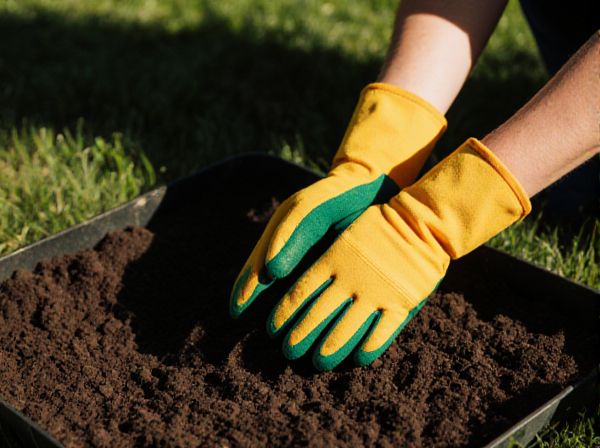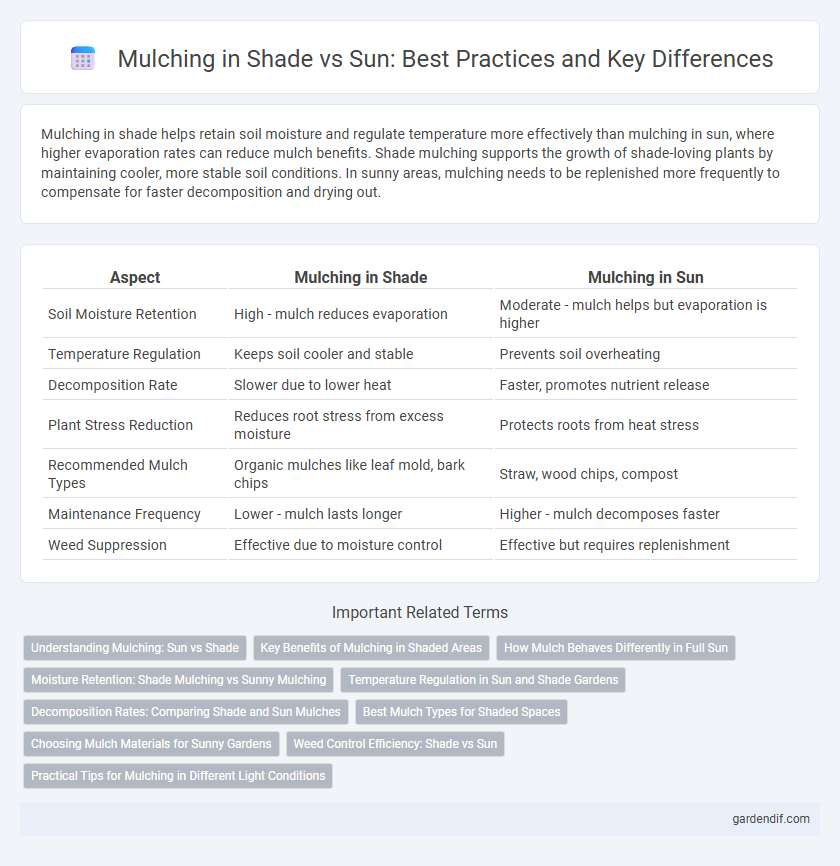
Mulching in shade vs mulching in sun Illustration
Mulching in shade helps retain soil moisture and regulate temperature more effectively than mulching in sun, where higher evaporation rates can reduce mulch benefits. Shade mulching supports the growth of shade-loving plants by maintaining cooler, more stable soil conditions. In sunny areas, mulching needs to be replenished more frequently to compensate for faster decomposition and drying out.
Table of Comparison
| Aspect | Mulching in Shade | Mulching in Sun |
|---|---|---|
| Soil Moisture Retention | High - mulch reduces evaporation | Moderate - mulch helps but evaporation is higher |
| Temperature Regulation | Keeps soil cooler and stable | Prevents soil overheating |
| Decomposition Rate | Slower due to lower heat | Faster, promotes nutrient release |
| Plant Stress Reduction | Reduces root stress from excess moisture | Protects roots from heat stress |
| Recommended Mulch Types | Organic mulches like leaf mold, bark chips | Straw, wood chips, compost |
| Maintenance Frequency | Lower - mulch lasts longer | Higher - mulch decomposes faster |
| Weed Suppression | Effective due to moisture control | Effective but requires replenishment |
Understanding Mulching: Sun vs Shade
Mulching in shade requires selecting materials that retain moisture and prevent fungal growth, such as pine needles or shredded leaves, while sun-exposed areas benefit from lighter mulch like straw or bark that reflect heat and conserve water. Shade mulches tend to decompose slower due to lower temperatures and less direct sunlight, maintaining soil temperature and moisture balance more effectively than sun mulches. Understanding these differences ensures optimal plant health by tailoring mulch choice to specific microclimate conditions.
Key Benefits of Mulching in Shaded Areas
Mulching in shaded areas helps retain soil moisture by reducing evaporation, which is crucial where sunlight is limited. It also suppresses weed growth without overly competing for nutrients, supporting healthier shade-tolerant plants. Moreover, mulching in shade improves soil structure and provides insulation, protecting roots from temperature fluctuations common in less sunny environments.
How Mulch Behaves Differently in Full Sun
Mulch in full sun heats up more quickly, accelerating organic matter decomposition and reducing moisture retention compared to shaded areas. In sunny conditions, mulch tends to dry out faster, necessitating more frequent replenishment to protect soil and roots. The increased temperature fluctuations also influence microbial activity, impacting nutrient cycling and soil health differently than in shaded mulch environments.
Moisture Retention: Shade Mulching vs Sunny Mulching
Mulching in shaded areas significantly enhances moisture retention by reducing soil evaporation more effectively than mulching in sunny locations, where higher temperatures accelerate water loss. Shade mulching maintains cooler soil temperatures, preserving soil moisture longer and promoting healthier root systems. In contrast, sunny mulching requires more frequent irrigation due to increased evaporation rates despite the protective mulch layer.
Temperature Regulation in Sun and Shade Gardens
Mulching in shade gardens significantly enhances temperature regulation by maintaining cooler soil compared to sun-exposed areas where mulch helps to buffer extreme heat fluctuations. In sun gardens, mulch reduces soil temperature spikes, preventing root damage and moisture loss, while in shaded environments, it stabilizes temperature to support sensitive plant roots. Effective mulching strategies tailored to sunlight conditions optimize moisture retention and create a favorable microclimate for plant growth.
Decomposition Rates: Comparing Shade and Sun Mulches
Mulching in shaded areas typically results in slower decomposition rates compared to mulching in full sun due to lower soil temperatures and reduced microbial activity. Sun-exposed mulches break down faster as heat accelerates moisture evaporation and microbial metabolism, enhancing nutrient release. Selecting mulch types and thickness should consider these differences to optimize soil health and plant growth in either environment.
Best Mulch Types for Shaded Spaces
Organic mulches like shredded leaves, pine needles, and composted bark retain moisture and improve soil structure in shaded areas by enhancing aeration and microbial activity. In contrast, rubber or stone mulches, better suited for sunny spaces, can reflect heat and may not support root health in low-light environments. Choosing mulch materials with high moisture retention and nutrient release optimizes plant growth and soil quality under shade conditions.
Choosing Mulch Materials for Sunny Gardens
Selecting mulch materials for sunny gardens involves prioritizing options that retain moisture and regulate soil temperature under high sun exposure. Organic mulches such as wood chips, straw, and shredded leaves are effective in insulating roots and reducing evaporation in sunny areas. Unlike mulching in shade, sunny garden mulches benefit from thicker layers to prevent rapid drying and protect plants from heat stress.
Weed Control Efficiency: Shade vs Sun
Mulching in shade significantly improves weed control efficiency by limiting sunlight penetration, which inhibits the germination and growth of many weed species compared to mulching in sun-exposed areas. In sunlit environments, mulches can degrade faster due to higher temperatures and UV exposure, potentially reducing their effectiveness in suppressing weeds over time. Consequently, shaded mulched areas maintain a more consistent barrier against weed proliferation, enhancing long-term garden health and maintenance.
Practical Tips for Mulching in Different Light Conditions
Mulching in shade requires selecting organic materials like shredded leaves or pine needles that retain moisture and improve soil aeration under low light. In sun-exposed areas, use lighter-colored mulches such as straw or bark chips to reflect heat and prevent rapid drying. Regularly monitor mulch depth, maintaining 2-3 inches to balance moisture conservation and air circulation for optimal plant health in varying light conditions.
Mulching in shade vs mulching in sun Infographic

 gardendif.com
gardendif.com